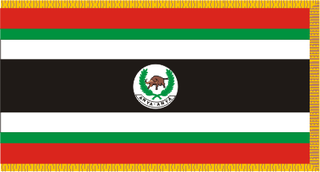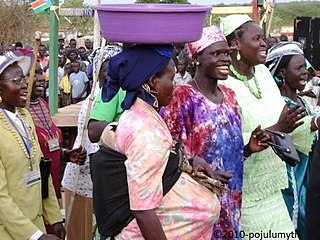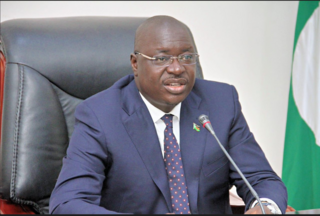The Nilotic peoples are people indigenous to the Nile Valley who speak Nilotic languages. They inhabit South Sudan, Sudan, Ethiopia, Uganda, Kenya, the eastern border area of Democratic Republic of the Congo, Rwanda, Burundi and Tanzania. Among these are the Burun-speaking peoples, Teso people also known as Iteso or people of Teso, Karo peoples, Luo peoples, Ateker peoples, Kalenjin peoples, Karamojong people also known as the Karamojong or Karimojong, Datooga, Dinka, Nuer, Atwot, Lotuko, and the Maa-speaking peoples.

Equatoria is the southernmost region of South Sudan, along the upper reaches of the White Nile and the border between South Sudan and Uganda. Juba, the national capital and the largest city in South Sudan, is located in Equatoria. Originally a province of Anglo-Egyptian Sudan, it also contained most of northern parts of present-day Uganda, including Lake Albert and West Nile. It was an idealistic effort to create a model state in the interior of Africa that never consisted of more than a handful of adventurers and soldiers in isolated outposts.

Central Equatoria is a state in South Sudan. With an area of 43,033 square kilometres (16,615 sq mi), it is the smallest of the original South Sudanese states. Its previous name was Bahr al-Jabal, named after a tributary of the White Nile that flows through the state. It was renamed Central Equatoria in the first Interim Legislative Assembly on 1 April 2005 under the government of Southern Sudan. Central Equatoria seceded from Sudan as part of the Republic of South Sudan on 9 July 2011. The state's capital, Juba, is also the national capital of South Sudan. On October 2, 2015, the state was split into three states: Jubek, Terekeka, and Yei River. The state of Central Equatoria was re-established by a peace agreement signed on 22 February 2020.

The Mundari are a small ethnic group of South Sudan. They are a part of the Karo people, one of the Karo ethnic Group

Juma Abdalla Oris was a Ugandan military officer and government minister under the dictatorship of Idi Amin. After fleeing his country during the Uganda–Tanzania War, he became leader of the West Nile Bank Front (WNBF), a rebel group active in the West Nile region of Uganda during the 1990s.

The First Sudanese Civil War was a conflict from 1955 to 1972 between the northern part of Sudan and the southern Sudan region that demanded representation and more regional autonomy. The war was divided into four major stages: initial guerrilla warfare, the creation of the Anyanya insurgency, political strife within the government and establishment of the South Sudan Liberation Movement. Around a million people died over the course of the nearly 17-year long war.
Kaya is a city in Central Equatoria, South Sudan.

The Anyanya were a southern Sudanese separatist rebel army formed during the First Sudanese Civil War (1955–1972). A separate movement that rose during the Second Sudanese Civil War were, in turn, called Anyanya II. Anyanya means "snake venom" in the Ma'di language.
Yambio is a city in South Sudan.
Bari is the Nilotic language of the Karo people, spoken over large areas of Central Equatoria state in South Sudan, across the northwest corner of Uganda, and into the Democratic Republic of Congo.

The Pojulu is a tribe of the savanna lands in the White Nile Valley, in the Equatoria region of South Sudan. They are Nilotic people and part of the Karo people — which also includes Bari, Mundari, Kakwa, Kuku, Nyangwara, and the Karo Tribes Of Omo Valley in Ethiopia such as the Banna, Hamer, Mursi, Kara, Dassanech, Arbore, Nyangatom known as the Omo Karo peoples.
The Karo is a group of Eastern Nilotic tribes that straddles the Nile in South Sudan and is predominately found in Central Equatoria, and as far South as Uganda and South-West as Democratic Republic of the Congo. Karo comprises Yangwara, Bari, Pojulu, Kuku, Mundari and Kakwa. They have been erroneously called Bari-speakers by C. G. Seligman, a British ethnologist, whose first contact with Karo was likely with the Bari during British colonial rule in Sudan. Seligman categorised the six ethnic groups as "Bari Speakers" for research purposes as he did so for "Dinka Speakers, Nuer Speakers, Lou Speakers, Moru Speakers and the Azande Speakers". These other groups however, have not adopted the categorization coined by G. Seligman for ethnic identification. It is only the "Bari Speakers" who are erroneously defined as speakers of Bari language.

South Sudan is home to around 60 indigenous ethnic groups and 80 linguistic partitions among a 2021 population of around 11 million. Historically, most ethnic groups were lacking in formal Western political institutions, with land held by the community and elders acting as problem solvers and adjudicators. Today, most ethnic groups still embrace a cattle culture in which livestock is the main measure of wealth and used for bride wealth.
The history of South Sudan comprises the history of the territory of present-day South Sudan and the peoples inhabiting the region.
Ethnic violence in South Sudan has a long history among South Sudan's varied ethnic groups. South Sudan has 64 tribes with the largest being the Dinka, who constitute about 35% of the population and predominate in government. The second largest are the Nuers. Conflict is often aggravated among nomadic groups over the issue of cattle and grazing land and is part of the wider Sudanese nomadic conflicts.

Morobo is one of the six counties in Central Equatoria state, South Sudan. Morobo County borders Uganda and Congo. The county is mainly occupied by Kakwa speaking people, Keliko and Lugbara. The people in Morobo are local farmers working for food. Morobo is part of the green belt and also acts as a breadbasket for Yei and Juba.

Yei River State was a state in South Sudan that existed from 2 October 2015 to 22 February 2020.

Yei River County is an administrative area in Central Equatoria with a large population of people who settled in that particular county.
Operation Thunderbolt was the codename for a military offensive by the South Sudanese SPLA rebel group and its allies during the Second Sudanese Civil War. The operation aimed at conquering several towns in Western and Central Equatoria, most importantly Yei, which served as strongholds for the Sudanese Armed Forces (SAF) and helped the Sudanese government to supply its allies, the Ugandan insurgents of the WNBF and UNRF (II) based in Zaire. These pro-Sudanese forces were defeated and driven from Zaire by the SPLA and its allies, namely Uganda and the AFDL, in course of the First Congo War, thus allowing the SPLA launch Operation Thunderbolt from the Zairian side of the border. Covertly supported by expeditionary forces from Uganda, Ethiopia, and Eritrea, the SPLA's offensive was a major success, with several SAF garrison towns falling to the South Sudanese rebels in a matter of days. Yei was encircled and put under siege on 11 March 1997. At the same time, a large group of WNBF fighters as well as SAF, FAZ, and ex-Rwandan Armed Forces soldiers was trying to escape from Zaire to Yei. The column was ambushed and destroyed by the SPLA, allowing it to capture Yei shortly afterward. Following this victory, the South Sudanese rebels continued their offensive until late April, capturing several other towns in Equatoria and preparing further anti-government campaigns.

[[File:|left|thumb|289x289px|A portrait of Emmanuel Adil Anthony]]













